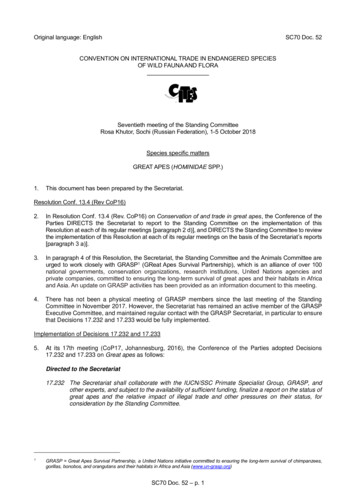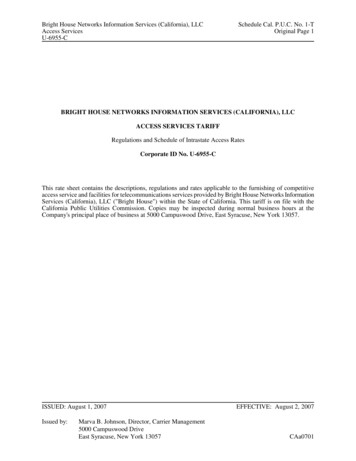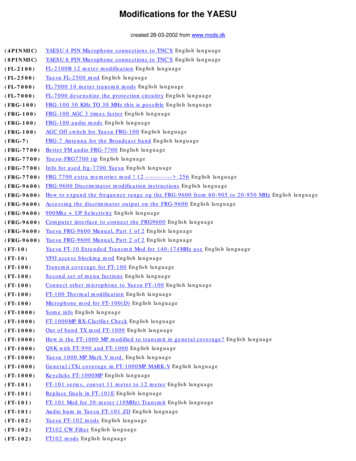
Transcription
Original language: EnglishSC70 Doc. 52CONVENTION ON INTERNATIONAL TRADE IN ENDANGERED SPECIESOF WILD FAUNA AND FLORASeventieth meeting of the Standing CommitteeRosa Khutor, Sochi (Russian Federation), 1-5 October 2018Species specific mattersGREAT APES (HOMINIDAE SPP.)1.This document has been prepared by the Secretariat.Resolution Conf. 13.4 (Rev CoP16)2.In Resolution Conf. 13.4 (Rev. CoP16) on Conservation of and trade in great apes, the Conference of theParties DIRECTS the Secretariat to report to the Standing Committee on the implementation of thisResolution at each of its regular meetings [paragraph 2 d)], and DIRECTS the Standing Committee to reviewthe implementation of this Resolution at each of its regular meetings on the basis of the Secretariat’s reports[paragraph 3 a)].3.In paragraph 4 of this Resolution, the Secretariat, the Standing Committee and the Animals Committee areurged to work closely with GRASP1 (GReat Apes Survival Partnership), which is an alliance of over 100national governments, conservation organizations, research institutions, United Nations agencies andprivate companies, committed to ensuring the long-term survival of great apes and their habitats in Africaand Asia. An update on GRASP activities has been provided as an information document to this meeting.4.There has not been a physical meeting of GRASP members since the last meeting of the StandingCommittee in November 2017. However, the Secretariat has remained an active member of the GRASPExecutive Committee, and maintained regular contact with the GRASP Secretariat, in particular to ensurethat Decisions 17.232 and 17.233 would be fully implemented.Implementation of Decisions 17.232 and 17.2335.At its 17th meeting (CoP17, Johannesburg, 2016), the Conference of the Parties adopted Decisions17.232 and 17.233 on Great apes as follows:Directed to the Secretariat17.232 The Secretariat shall collaborate with the IUCN/SSC Primate Specialist Group, GRASP, andother experts, and subject to the availability of sufficient funding, finalize a report on the status ofgreat apes and the relative impact of illegal trade and other pressures on their status, forconsideration by the Standing Committee.1GRASP Great Apes Survival Partnership, a United Nations initiative committed to ensuring the long-term survival of chimpanzees,gorillas, bonobos, and orangutans and their habitats in Africa and Asia (www.un-grasp.org)SC70 Doc. 52 – p. 1
Directed to the Standing Committee17.233 The Standing Committee shall consider the report prepared in accordance with Decision 17.232,and prepare recommendations for further action as may be needed, to be considered at the 18thmeeting of the Conference of the Parties.6.At the 69th meeting of the Standing Committee (SC69, Geneva, November 2017), the Secretariat gavean oral update on activities carried out with regard to Resolution Conf. 13.4 (Rev. CoP16). It explainedthat, in relation to Decision 17.232, it was originally hoped that the report would have been ready forsubmission to that meeting, but that, for various reasons, this was not possible. In order to move the studyforward, a revised timeline was proposed by GRASP, the CITES Secretariat and the International Unionfor Conservation of Nature (IUCN), which was accepted by the Standing Committee, such that the finaldraft of the status report can be presented for consideration at this meeting of the Standing Committee.7.It was also suggested that, as the study called for in Decision 17.232 is largely scientific in nature, it wouldgreatly benefit from input from the Animals Committee. The Chair of the Animals Committee stated thatthe Animals Committee would gladly review and provide comments on the study, once received. TheStanding Committee requested the Secretariat to submit the report undertaken in accordance withDecision 17.232 to the Animals Committee for its consideration (SC69 Summary Record).8.A draft report was prepared by the GRASP Secretariat in collaboration with a number of experts, includingthose from the Primate Specialist Group of the Species Survival Commission (SSC) of IUCN, andsubmitted for review and comments by the Animals Committee at its 30th meeting (see document AC30Doc. 26).9.Through an in-session working group, the Animals Committee recommended that the Secretariat providea series of observations for the authors to consider on ways to update and improve the presentation ofthe report [see document AC30 Com 2. (Rev. by Sec.)].10. A revised and final report has been prepared for SC70, taking into consideration the comments from theAnimals Committee. This report is attached as an Annex to this document.11. To facilitate the implementation of Decision 17.233, the Standing Committee established an intersessionalworking group on great apes at SC69, with a mandate to: review the report finalized by the Secretariat inaccordance with Decision 17.232, and any recommendations coming from the Animals Committee; andreport to SC70 with any draft recommendations. The membership was determined as follows: Canada(Chair), China, European Union, France, Indonesia, Malaysia, Nigeria, Thailand, United Kingdom of GreatBritain and Northern Ireland, and the United States of America; and Animal Advocacy and Protection (AAP),Born Free Foundation, Convention on Migratory Species, Food and Agriculture Organization, InternationalUnion for Conservation of Nature, TRAFFIC, Wildlife Conservation Society, Wildlife Impact, and the WorldAssociation of Zoos and Aquariums.12. Unfortunately, due to the short timeframe between the end of the meeting of the Animals Committee and thedate of submission of documents for this meeting, the intersessional working group was unable to completeits mandate in time to submit a written report to this meeting.13. With the document now available, the intersessional working group has confirmed that it will continue workinguntil the present meeting to fulfil the tasks outlined in its mandate. The Chair of the working group will providean oral update at this meeting.Recommendations14. The Standing Committee is invited to:a)review the report in the Annex, taking into account any information from the Standing Committee’sintersessional working group on great apes, and consider recommendations for further action as maybe needed;b)consider requesting the Secretariat, in consultation with GRASP and the Chair of the StandingCommittee, to review the current provisions in Resolution Conf. 13.4 (Rev. CoP16) on Conservationof and trade in great apes, and, taking account of recommendations emanating from the report,SC70 Doc. 52 – p. 2
propose as appropriate amendments to the Resolution, for consideration at the 18th meeting of theConference of the Parties; andc)confirm that Decisions 17.232 and 17.233 have been fully implemented.SC70 Doc. 52 – p. 3
SC70 Doc. 52AnnexGreat Apes Status Report(August 2018)Great Apes Survival Partnership & International Union for Conservation of NatureEditors: J. Refisch1, S.A. Wich2,3,4 & E.A. Williamson3,5Population data analysis, compilation and maps: T. Sop, IUCN SSC A.P.E.S. database manager 6With contributions and reviews by (in alphabetical order): M. Ancrenaz 3,4,7, R.A. Bergl3,4,8,D. Greer3,9, T. Humle3,10, R. Kormos11, H.S. Kühl3,4,6, E.J. Macfie3, F. Maisels3,5,12,J.F. Oates3,13, M.M. Robbins4,6, J. Sherman14 & T. Sop61Great Apes Survival Partnership, United Nations Environment Programme (UNEP), P.O. Box 30552, 00100 Nairobi,Kenya2John Moores University Liverpool, School of Natural Sciences and Psychology, Liverpool L3 5UA, UK3Executive Committee of IUCN SSC Primate Specialist Group (PSG) Section on Great Apes (SGA)4Scientific Commision of Great Apes Survival Partnership (GRASP)5Faculty of Natural Sciences, University of Stirling, Stirling, FK9 4LA, UK6Max Planck Institute for Evolutionary Anthropology, Deutscher Platz 6, 04103 Leipzig, Germany7HUTAN – Kinabatangan Orangutan Conservation Programme, P.O. Box 17793-88874, Kota Kinabalu, Malaysia8North Carolina Zoo, 4401 Zoo Parkway, Asheboro, North Carolina, USA9WWF Uganda, Kampala, Uganda10Durrell Institute of Conservation and Ecology (DICE), School of Anthropology and Conservation, University of Kent,Canterbury CT2 7NR, UK11Department of Integrative Biology, University of California, Berkeley, California, USA12Wildlife Conservation Society, Global Conservation Program, 2300 Southern Boulevard, Bronx, New York, NY10460, USA13Department of Anthropology, Hunter College, 695 Park Avenue, New York, NY 10065, USA14Wildlife Impact, P.O. Box 31062, Portland, OR 97231, USACitation: GRASP & IUCN (2018). Report to the CITES Standing Committee on the Status of Great Apes.United Nations Environment Programme Great Apes Survival Partnership, Nairobi, and International Unionfor Conservation of Nature, Gland.SC70 Doc. 52 Annex – p. 1
Table of contents1. Introductionp. 32. African great apesp. 32.1. Current distribution of African great apesp. 32.2. African great ape population sizesp. 42.2.1. Population size estimates per countryp. 42.2.2. Population size estimates per taxonp. 62.3. Temporal trends in African great ape populationsp. 72.4. Threats to African great apesp. 93. Asian great apesp. 123.1. Current distribution of Asian great apesp. 123.2. Asian great ape population sizesp. 133.2.1. Population size estimates per countryp. 133.2.2. Population size estimates per taxonp. 143.3. Temporal trends in Asian great ape populationsp. 143.4. Threats to Asian great apesp. 154. Description of threatsp. 165. International agreements specific to great ape range Statesp. 196. Challenges and solutionsp. 207. Recommendationsp. 228. Main sources of informationp. 239. Acknowledgementsp. 2310. Referencesp. 24Annex I. Acronymsp. 34SC70 Doc. 52 Annex – p. 2
Report to the CITES Standing Committee on the Status of Great Apes1. IntroductionThe 65th meeting of the Standing Committee of the Convention of International Trade in Endangered Species of WildFauna and Flora (CITES) mandated the CITES Secretariat (SC65, Doc37) to collaborate with the IUCN SSC PrimateSpecialist Group, the Great Apes Survival Partnership (GRASP) and other experts, to prepare a report on the status ofgreat apes and the relative impact of illegal trade and other pressures on their status, for consideration by the StandingCommittee. This report constitutes fulfilment of the mandate received from the CITES Secretariat and will addressdistribution and abundance trends related to all great ape species and sub-species, as well as threats to their conservation.The great apes (bonobos, chimpanzees, eastern and western gorillas, Bornean, Sumatran and Tapanuli orangutans) facesignificant conservation threats and are listed as either Endangered or Critically Endangered by the IUCN Red List ofThreatened Species (IUCN, 2018) and on Appendix I of CITES (CITES, 2017). All great apes have slow rates ofreproduction due to their prolonged maturation and high investment in single (occasionally twin) offspring: age at firstreproduction is late, their young take a long time to develop, and interbirth intervals are 4–9 years, depending on thespecies. Their populations are, therefore, highly vulnerable to even low levels of offtake, and unable to cope withsignificant and continued losses of individuals.Great ape populations in Africa and Asia are threatened by the combined impacts of habitat loss, degradation andfragmentation, poaching, disease and illegal trade. It is illegal to kill or capture great apes and to trade live animals ortheir body parts in all great ape range States (IUCN, 2018). However, despite legal protection, law enforcement remainsa major challenge in many countries, and poaching, especially for the illegal domestic (and some international, albeitmostly regional, between neighbouring countries) trade in bushmeat, is the most significant threat to the survival of mostgreat apes (see Section 4 and Table 10).This report presents the current distribution of African and Asian great apes, as well as temporal population trends(changes over time) and the main threats to their survival. It also highlights current conservation challenges and providesa list of recommendations to the CITES Parties, the CITES Secretariat and other relevant stakeholders.2. African great apes2.1. Current distribution of African great apesAfrican great apes occur in 21 countries across Equatorial Africa (Figure 1). There are four species and nine taxa overall(Table 1).Table 1. The African great apesGenusGorilla2 speciesPan2 speciesSpecieseastern gorillaGorilla beringei2 subspecieswestern gorillaGorilla gorilla2 subspecieschimpanzeePan troglodytes4 subspeciesbonoboPan paniscusSubspeciesGrauer’s gorillaGorilla beringei grauerimountain gorillaGorilla beringei beringeiCross River gorillaGorilla gorilla diehliwestern lowland gorillaGorilla gorilla gorillacentral chimpanzeePan troglodytes troglodyteseastern chimpanzeePan troglodytes schweinfurthiiNigeria-Cameroon chimpanzeePan troglodytes elliotiwestern chimpanzeePan troglodytes verusNo subspecies currently recognizedSC70 Doc. 52 Annex – p. 3
Figure 1. Geographic distribution of African great ape taxa and sites (IUCN SSC A.P.E.S. database, 20172), Max PlanckInstitute for Evolutionary Anthropology.2.2. African great ape population sizesThe African great ape population estimates in this report are based on surveys conducted in the past 10 years. “Site” inthis text refers to any area in which surveys were conducted in the last 10 years, including amongst others protected areasand their buffer zones, a logging concession or a group of concessions. Population estimates presented in this report aredrawn from peer-reviewed publications, published or unpublished reports, data from research and conservationorganizations, or are expert estimates. Estimating population size is complex, because great apes are difficult to observe.All great apes build a new nest to sleep in every night, and these can be used as proxies for independent nest-buildinganimals. A software package (Distance) incorporates animal sign production (in this case night nests) and decay rate tocalculate the density of animal sign and of population (Thomas, et al., 2010). Because sample size can be small whereape density is low, the resulting estimates of abundance often show a great deal of variation in precision (see Kühl, et al.,2008). At some sites, genetic censusing is used (e.g. Arandjelovic, et al., 2011; Gray, et al., 2013; Roy, et al., 2014). Anoverview of survey methods can be found in Kühl, et al. (2008).2.2.1. Population size estimates per countryThere is great disparity in population estimates from taxon to taxon depending on the survey method used and samplingeffort. Chimpanzee, gorilla and bonobo population estimates per range State are presented in Table 2. The DemocraticRepublic of Congo (DRC) and Congo host the highest combined population sizes of great apes in Africa, followed byCameroon, Guinea and Gabon. Countries with the lowest great ape population numbers include Burundi, Ghana, Rwanda,Mali and Senegal, which each hosts a few hundred great apes.Table 2. African great ape population estimates by country. Except for mountain gorillas, estimates are based on thenumber of “nest builders”, thus excluding infants. Estimates are derived from both surveys and modelling approaches.2Ape Populations, Environments and Surveys database (http://apesportal.eva.mpg.de/)SC70 Doc. 52 Annex – p. 4
This is the best information available. However, survey effort is often highest in protected areas, while other areas remainunsampled, thus can lead to low country estimates.CountryTaxonwestern lowland gorillaAngolacentral chimpanzeeBurundieastern chimpanzeeCross River rindberg, et al. (2018)*2005–20132011–2013Hakizimana & Huynen (2013)western lowland rg, et al. (2018)*central chimpanzee21,489(18,575–40,408)2005–2013IUCN SSC A.P.E.S. database(2017); Strindberg, et al. ��2006Morgan, et al. (2011); Mitchell,et al. (2015);Oates, et al. (2016)western lowland gorilla5529(3,635–8,581)2015N’Goran, et al. (2016)central chimpanzee2,843(1,194–4,855)2015Strindberg, et al. (2018)eastern chimpanzee910 (538–1,534)2012–2016Aebischer, et al. (2017)215,799(180,814–263,913)2005–2013central n chimpanzee580 (332–940)2007–2015Tiédoué, et al. (2016); IUCNSSC A.P.E.S. database (2017)Grauer's gorilla3,8002011–2015Plumptre, et al. (2016a)mountain gorillaN/A†Dunn, et al. (2014)Strindberg, et al. (2018)*central chimpanzeepresent (populationsize unknown)N/AInogwabini, et al. (2007)eastern chimpanzee173,000–248,0002010Plumptre, et al. (2010)2012IUCN & ICCN ticRepublic 4(122–339)Surveyperiod132–194western lowland gorillaCôte d’IvoireAbundancewestern lowland gorillacentral chimpanzeewestern lowland gorillaGaboncentral 37(36,869–60,476)2005–2013Strindberg, et al. (2018)*2005–20132005–2013Ghanawestern chimpanzee2642009Guineawestern Bissauwestern chimpanzee1,000–1,5002016Liberiawestern chimpanzee7,0082011–2012SC70 Doc. 52 Annex – p. 5Strindberg, et al. (2018)*Danquah, et al. (2012)WCF (2012; 2014)Kühl, et al. (2017)Chimbo Foundation (2017)unpubl. dataTweh, et al. (2015)
(4,260–11,590)MaliNigeriawestern chimpanzeepresent (populationsize unknown)2014PanAf (2014) unpubl. dataCross River �2,0952005Dunn, et al. (2014)Morgan, et al. (2011); Oates, etal. (2016); S. Nixon, pers.comm.mountain gorillaN/A†eastern chimpanzee430Rwanda2009–2014IUCN SSC A.P.E.S. database(2017)western 7South Sudaneastern chimpanzeepresent2011Plumptre, et al. (2016b)Tanzaniaeastern chimpanzee2,5002010–2012Plumptre, et al. (2016b)Sierra Leonewestern chimpanzeeSenegalUganda†mountain gorilla400eastern chimpanzee5,0002009Brncic, et al. (2010)2011Pruetz & Wessling unpubl. dataRoy, et al. (2014)2006–2017Plumptre, et al. (2016b)* Strindberg, et al. (2018) estimate population sizes in 2013; western lowland gorilla numbers will have declined by afurther 13% overall by the end of 2018.† Bwindi mountain gorilla population only.2.2.2. Population size estimates per taxonWestern lowland gorillas and eastern chimpanzees are the most numerous great ape taxa, while the Cross River gorillahas the smallest population size, with approximately 300 or fewer mature individuals remaining.Table 3. African great ape population estimates by taxon in descending order of abundance. Except for mountain gorillas,estimates are based on the number of “nest builders”, thus excluding infants. Estimates are derived from both surveysand modelling approaches. The IUCN Red List classification of most great ape taxa is based on the rate of decline overthree generations (one generation time equating to 20–25 years, depending on the taxon).Taxonwestern lowland gorillaGorilla g. gorillaeastern chimpanzeePan t. central chimpanzeePan t. troglodyteswestern chimpanzeePan t. verusbonoboPan paniscusNigeria-CameroonchimpanzeePan t. elliotiGrauer’s gorillaGorilla b. grauerimountain gorillaGorilla b. beringeiIUCN StatusSourceCritically EndangeredStrindberg, et al. (2018)181,000–256,000EndangeredPlumptre, et al. (2010; rg, et al. (2018)18,000–65,000Critically EndangeredHumle, et al. (2016); Kühl, et al.(2017)15,000–20,000minimumEndangeredIUCN & ICCN (2012)4,400–9,345EndangeredMorgan, et al. (2011); Oates, et al.(2016)Critically EndangeredPlumptre, et al. (2015; 2016b)3,800(1,280–9,050)Roy, et al. (2014); Hickey, et al. (inprep.)§Dunn, et al. (2014); Bergl, et al.Cross River gorilla 300Critically Endangered(2016); R. Bergl & J. Oates pers.Gorilla g. diehlicomm.* Estimated in 2013. At an annual rate of decline of 2.7%, the population will be 316,000 by the end of 2018.§ Hickey, et al. (in prep.) will report the results of the 2015–2016 survey in the Virungas; a survey of BwindiImpenetrable National Park is still in progress. 1,000Critically Endangered2.3. Temporal trends in African great ape populationsSC70 Doc. 52 Annex – p. 6
With the exception of the mountain gorillas, all African great ape taxa are facing an overall decline, some of them drastic.The extent of the decline, however, differs between taxa, with Grauer’s gorillas suffering the highest estimated lossesover a short period of time (Table 4)3.Grauer’s gorilla, Gorilla beringei graueriIn 1995, the Grauer’s gorilla population was estimated at 16,900 (Hall, et al., 1998). By 2015, however, estimates placedtheir population at only 3,800 individuals, with an annual rate of decline of 7.2%. This represents a decline estimated atbetween 84–93% across the subspecies’ range. Comparing the 1994 data to that of 2011–2015, researchers found a 77%reduction in abundance. The subspecies is classified as Critically Endangered. Source: Plumptre, et al. (2015; 2016a).Mountain gorilla, Gorilla beringei beringeiWhilst the mountain gorilla is the only great ape taxon increasing in numbers, it has been listed as Critically Endangered,with an estimated population of 880 individuals in the early 2010s, increasing to over 1,000 individuals in 2016. Thereare two small isolated populations, the Virunga and the Bwindi populations, both of which have been the subject of intenseconservation, research and survey efforts over the last 40 years (e.g. Robbins, et al., 2011). Numbers in the Virungasdwindled to an estimated 250 individuals in 1981, before the population was allowed to recover and almost doubledbetween 1989 and 2010. Between 2003 and 2010, the population increased by 26% at an annual rate of 3.7% (Gray, etal., 2013).Cross River gorilla, Gorilla gorilla diehliCross River gorilla population changes are unknown. The subspecies is classified as Critically Endangered because of asmall and highly fragmented population: each subpopulation is likely to number fewer than 50 mature individuals. Source:Bergl, et al. (2016).Western lowland gorilla, Gorilla gorilla gorillaThe Critically Endangered western lowland gorilla population declined by 19.4% between 2005 and 2013, an annual lossof approximately 2.7% (Strindberg, et al., 2018). Although their geographic range is large, they are threatened bybushmeat poaching, disease (including Ebola virus disease), and habitat loss and degradation.Central chimpanzee, Pan troglodytes troglodytesThis subspecies is classified as Endangered, having experienced a significant population reduction since the 1970s. Theprincipal threats to this taxon, as for western lowland gorillas, are bushmeat poaching, disease, and habitat loss anddegradation. An analysis of nest survey data collected between 2003 and 2013 across the entire geographic range did notdetect a statistically significant decline (Strindberg, et al., 2018). Unlike gorillas, where an adult male will confrontdanger, chimpanzees slip away stealthily, and more often escape being killed. However, the factors known to reducechimpanzee populations (lack of forest guards, remoteness from roads, human population density, degree of forestintactness, etc.) were found to be significantly correlated with population density in the direction predicted (Strindberg,et al., 2018). All of these factors are increasing in either extent or intensity, or both, so we predict that a decline will bestatistically easier to detect in the future.Eastern chimpanzee, Pan troglodytes schweinfurthiiThe Albertine Rift escarpment in DRC is a stronghold for eastern chimpanzees, but recent surveys indicate 80–98%declines at some key sites in just 20 years, contributing to the major population declines seen in recent decades. It isestimated that populations in eastern DRC declined significantly (range of estimated decline 22–45%) between 1994 and2015. Eastern chimpanzees are listed as Endangered. Source: Plumptre, et al. (2016b).Nigeria-Cameroon chimpanzee, Pan troglodytes elliotiThis taxon has the lowest estimated population size of any chimpanzee subspecies. Its range is limited to clearly definedareas in southern Nigeria and central-southwest Cameroon. Its Endangered listing is based on an inferred population sizereduction of between 50–80% over a three-generation period from the mid-1980s to 2060. Source: Oates, et al. (2016).Past presence of chimpanzees in Benin and Togo has been very poorly documented, but if chimpanzees were in thosecountries, it is probable that they belonged to this subspecies.Western chimpanzee, Pan troglodytes verusThis subspecies, Pan troglodytes verus, has recently been upgraded to Critically Endangered as it is expected toexperience a decline exceeding 80% over the next 69 years, i.e. three generations (Humle et al., 2016). It is found in WestAfrica from Senegal to Ghana but has almost certainly become extinct in Burkina Faso in the 20 th century (Ginn, et al.,2013; Campbell & Houngbedji, 2015). With a likelihood of probably more than 18,850 individuals, Guinea now hoststhe largest remaining western chimpanzee population. Liberia and Sierra Leone are also strongholds for this subspecies3Some text in Sections 2.3 and 3.3 is taken from the IUCN Red List assessments, as indicated by “Source”.SC70 Doc. 52 Annex – p. 7
(Kühl, et al., 2017). Approximately 17,000 individuals (half of the total western chimpanzee population) live in the FoutaDjallon region of Guinea (Regnaut & Boesch, 2012). Between 1990 and 2015, the Côte d’Ivoire population declined by80% (Kühl, et al., 2017); only a few hundred individuals remain in Taï and Comoé National Parks (Campbell, et al.,2008). Between 2008 and 2011, the population in Lagoas de Cufadas National Park in Guinea-Bissau declined by morethan 60% (Carvalho, et al., 2013).Bonobo, Pan paniscusEndemic to the DRC, the Pan paniscus population is estimated to have declined sharply in the last 15–20 years. Thisdecline is projected to exceed 50% over a 75-year period from 2003 to 2078. The species is listed as Endangered. Source:Fruth, et al. (2016).Table 4. African great ape population trends by taxon in descending order of abundance. Except for mountain gorillas,estimates are based on the number of “nest builders”, thus excluding infants. Estimates are based on both surveys andmodelled results.Taxonwestern lowlandgorillaGorilla g. gorillaeasternchimpanzeePan t.schweinfurthiicentralchimpanzeePan t. troglodyteswesternchimpanzeePan t. verusbonoboPan paniscusNigeria-CameroonchimpanzeePan t. elliotiGrauer’s gorillaGorilla b. graueriAnnualrate ofchangeTotalestimatedchangePeriodassessedSource of trend –2.7%–19.4%2005–2013Strindberg, et 45%†1994–2014Plumptre, et al.(2015; 2016b)128,760(114,208–317,039)*Declining –4.95% –50%2005–2013Maisels, et al.(2016b)18,000–65,000*Declining –6.43%–80%1990–2015Kühl, et al. 54.9%2003–2015 –1% –50%2003–2078Fruth, et s, et al.(2016)–7.2%–94.2%1994–2015Plumptre, et al.(2016a, lining4,400–9,3453,800(1,280–9,050) Declining Declining øGray, et al.(2013); Roy, et al. 1,000 3.7% 26% ‡2003–2010(2014); Hickey, etal. (in prep.)Dunn, et al.Declining(2014); R. BerglCross River gorilla 300N/AN/AN/AGorilla g. diehli& J. Oates pers. comm.* Surveys conducted in 2003–2013 in western equatorial Africa were used to estimate total population size.† 22–45% decline estimated for eastern DRC only, not for the entire geographic range.§ The confidence interval for this analysis is very large, suggesting an uncertainty in the data.ø There is uncertainty surrounding the 5.95% annual decline; however, Fruth, et al. (2016) state that an annual loss of1% would still lead to 50% decline of the bonobo population by 2078.‡ Virunga population only. No estimate available for the Bwindi population due to changes in sampling method.mountain gorillaGorilla b. beringeiIncreasing 2.4. Threats to African great apesThreats are discussed in detail in Section 4. The most important threats to great apes in Africa are poaching for bushmeat,habitat loss and degradation, and infectious diseases. The term “poaching” is used as a synonym for illegal killing, butcan have different motives, such as obtaining bushmeat or retaliation for crop foraging. Great apes may also becomeaccidental victims of snares set for other species (see poaching categories in Table 10 of Section 4). Illegal trafficking ofSC70 Doc. 52 Annex – p. 8
live infants is also an issue in some areas. The levels of these threats vary greatly between taxa (Table 5). Western lowlandgorillas and central chimpanzees are treated together because their ranges overlap by 97% (Strindberg, et al., 2018).Grauer’s gorilla, Gorilla beringei graueriEven though all killing, capture and consumption of great apes is illegal in the DRC, bushmeat poaching presents themost serious and immediate threat to Grauer’s gorillas. This concerns the entire geographic range with a high demand forbushmeat created by the growing human population and widespread artisanal mining in remote areas (Kirkby, et al., 2015;Plumptre, et al., 2015, 2016a). Miners working in Grauer’s gorilla habitat admit to poaching gorillas, considering themto be relatively easy to hunt with guns and providing large quantities of meat (Kirkby, et al., 2015, Spira, et al., 2017).Indiscriminate and conflict poaching also occur. Habitat loss and degradation, mainly driven by artisanal mining, farming(slash-and-burn agriculture) and livestock ranching to supply regional markets, also constitutes a major threat. There iscurrently no commercial logging
SC70 Doc. 52 Annex - p. 3 Report to the CITES Standing Committee on the Status of Great Apes 1. Introduction The 65th meeting of the Standing Committee of the Convention of International Trade in Endangered Species of Wild Fauna and Flora (CITES) mandated the CITES Secretariat (SC65, Doc37) to collaborate with the IUCN SSC Primate










